In contrast to Traumatic Ulcerative Granuloma with Stromal Eosinophilia, these lesions are squamous cell carcinomas of the tongue. They can look similar, but squamous cell carcinomas are a bit more involved.
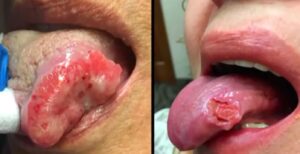
Don’t have time to read this article? We get it. Download the Diagnosing Vesicular Ulcerative Conditions checklist to get the key information and images from this article plus all the other conditions we cover in the Dentist’s Guide to Oral Pathology.

The histology here is overlying, stratified squamous epithelium. Sometimes this seems plastic, a little acellular. Then you have malignant epithelial islands in the connective tissue. You see that there’s a little bit of spindling and some of the cells are producing keratin, individual cell keratinization.


Sometimes you can see keratin pearl formation. That’s what we see in this squamous cell. You can see this transitioning from the overlying epithelium.
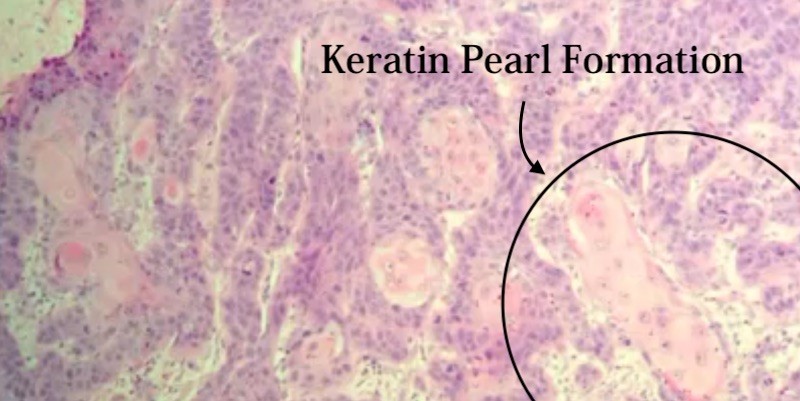
This is a histologic picture of vascular invasion. You have a thin-walled vessel, maybe a limb for a capillary, and you have cancer that has broken through that vascular wall and entering the lumen. This is the first step in metastasis.
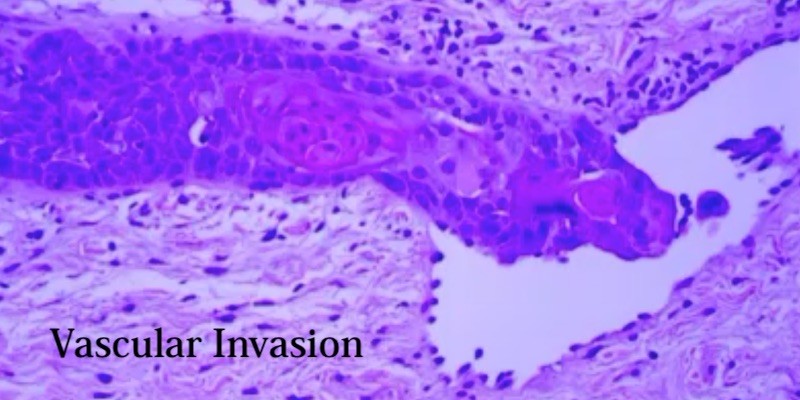
Here we can see large pleomorphic cells with several nucleoli. Some cells are large with one prominent, cherry-red nucleoli. We see mitotic activity and abnormal mitosis which is one of the hallmarks of squamous cell carcinoma. We look for cells that look different in shape and size and staining in atypical mitotic activity.

Squamous Cell Carcinoma of the Oral Cavity and Oropharynx
In general, we combine the oral cavity and oropharynx statistics into one. However, it’s two separate entities. If you do combine them as the American Cancer Society does, this is the 2014 data.
- Oral cavity and Oropharyngeal Squamous Cell Carcinoma (OPSCC) affects about 41,000 people in the US with about 8,000 deaths.
- The male to female ratio is 2:1.
- Overall 5-year survival is not great at 62%,
- It’s the eighth most common cancer in men.
Oral Cavity and Oropharyngeal Squamous Cell Carcinoma (OPSCC) Association with HPV
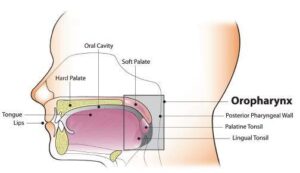
I’m sure you’ve heard of HPV associated with cervical cancer. HPV is also associated with Oropharyngeal Squamous Cell Carcinoma. The oropharynx is posterior to the posterior aspect of the oral cavity. You’re talking about the tonsils, the soft palate, and the base of the tongue.
If you have a squamous cell carcinoma of the oropharynx , the chances are that 73% of cases would be related to HPV. There is a wide range here, but it is about 73% or higher in more recent studies. The reason for the broad range is because studies sometimes define the oropharynx to include the posterior, one-third of the tongue and which decreases the number.
The oral cavity is not frequently associated with HPV. Only about 2% of oral cavity squamous cell carcinomas are HPV related. Location here is critical.
Oropharyngeal squamous cell carcinoma (OPSCC), the overwhelming majority, are related to HPV infection. Oral cavity squamous cell carcinoma, the majority, are not associated with HPV.
Oropharyngeal Squamous Cell Carcinomas Trends
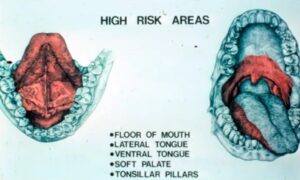
We know that the high-risk areas remain the same: lateral borders of the tongue, ventral tongue, the floor of the mouth, soft palate. We know that soft palate tonsillar pillars and base of tongue regions are more subject to infection with HPV and therefore are often associated with HPV associated carcinomas.
In 2011 a study looked at the incidents and proportion of OPSCC. They found that both were increasing. They looked at cases in 1998 compared to 2004, and they found that there was a 30% increase in OPSCC. They found that this was primarily amongst younger men and was often diagnosed at a late stage because you don’t think of squamous cell carcinoma of the oral cavity and oropharynx occurring in younger man or younger patients in general.
Interestingly, they also found that the proportion of HPV positive squamous cell carcinomas was increasing as well. They took samples from the 1980s and tested them for HPV16 and HPV18. Then they took samples from 2000 and tested for HPV16 and HPV18 and compared them to the 80s.
The samples from the 1980s were 16% HPV positive, and in 2000 they were 73% HPV positive. Not only are the incidents increasing, but the proportion of oropharyngeal squamous cell carcinoma related to HPV is rising.
Vesicular Ulcerative Conditions
Download the Diagnosing Vesicular Ulcerative Conditions checklist to get all the key information and images from this article.

Postgraduate Oral Pathology and Radiology Certificate
Learn more about the clinical and didactic skills necessary to evaluate and manage patients with oral diseases by enrolling in Herman Ostrow School of USC’s online, competency-based certificate program in Oral Pathology and Radiology.

